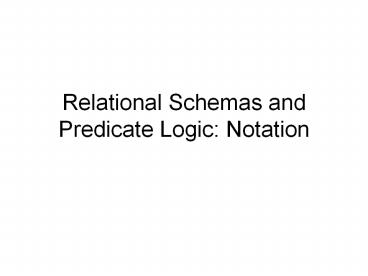Relational Schemas and Predicate Logic: Notation - PowerPoint PPT Presentation
Title: Relational Schemas and Predicate Logic: Notation
1
Relational Schemas and Predicate Logic Notation
2
Relations
- Let E1,..,En be sets of entities or objects (we
may have Ei Ej). - The Cartesian product E1 x x En is the set of
tuples of the form (e1,..,en) where ei is in set
Ei. - A relation R on E1,..,En is a subset of the
Cartesian product E1 x x En. We say that n is
the arity of the relation. Note that a relation
may be unary.
3
Relational Schemas
- A schema specifies a finite set of relations
R1,..Rn with additional structure - Each column/field in a relation gets a name (can
also just use position) and a domain. - A subset of fields is identified as the key.
- The non-key fields are often called (descriptive)
attributes. The values of the attributes are
determined by the values of the key field. - Common Notation
- Student(Namestring,GPAnumeric,Ageinteger)
- Registered(Namestring,Coursestring,gradenumeric
)
4
ER Model Entities
- Entity Real-world object distinguishable from
other objects. An entity is described (in DB)
using a set of attributes. - Entity Set A collection of similar entities.
E.g., all employees. - All entities in an entity set have the same set
of attributes. - Each entity set has a key.
- Each attribute has a domain.
- A key defines the values of attributes---the
attributes are functions of the keys.
5
ER Model Relationships
name
ssn
lot
Employees
since
name
dname
super-visor
subor-dinate
budget
ssn
lot
did
Reports_To
Works_In
Departments
Employees
- Relationship Association among two or more
entities. E.g., Attishoo works in Pharmacy
department. - Relationship Set Collection of similar
relationships. - An n-ary relationship set R relates n entity
sets E1 ... En each relationship in R involves
entities e1, ..., en - Same entity set could participate in different
relationship sets, or in different roles in
same set.
6
Notes on ER relationships
- Note that relationships can have descriptive
attributes too. - The values of the descriptive attributes are
determined once we have identified the entities
involved grade(Joe,CMPT354). - The fields that identify the entities involved
are callled foreign key pointers.
7
Relational Instance and Finite Models
- A relational instance is a relational schema
set of tuples specified for each relation. - The list ltR1,..,Rngt of relations (with tuples
specified, but without field names and key
constraints) is called a finite model in logic.
8
Graphical Visualization
- A graph on set S is a binary symmetic relation
over S x S. - If the relation instance contains only one binary
symmetric relation, it can be visualized as a
graph whose edges and nodes are annotated with
the values of descriptive attributes. - Classic social network analysis considers only
the graph structure, not the attributes.
9
Translating Schemas Into Logic no functions
- Each relation of arity n ? predicate symbol with
n arguments. - E.g., A student with GPA 3.0 is younger than 40
? Student(S,G,A) AND G 3.0 ? A lt 40. - Pros
- Simple Translation.
- Simple logic.
- Cons
- Loses information about key fields.
- Not always natural to read.
10
Translating Schemas Into Logic Functions
- Introduce one function symbol for each
descriptive attribute. The arguments are the key
fields. - E.g., Age(S), grade(S,C). Also
S.age,Registered.grade. - E.g., A student with GPA 3.0 is younger than 40
? GPA(S) 3.0 ? Age(S) lt 40. - Pros
- Keeps information about keys and foreign keys.
- Natural to read.
- Cons a bit more complex mathematically.
11
Formal definitions in logic
- Use the function-free formulation, with predicate
symbols R1,..,Rn. - The language contains a set of constants and
variables. - A term is a constant or a variable.
- An atom is
- a predicate symbol with the required numbers of
terms, e.g. Student(N,G,40), Student(Jack,3.0,40).
- A comparison of terms, e.g. X gt 3, X Y, 5 gt 1.
- A literal is an atom or a negated atom.
12
Clauses
- A clause is a set of literals.
- The negated literals are called the body, the
positive ones the head. - A clause is often written in implication form b1
AND b2 ? h1. - Also h1 - b1,b2.
- A clause with a single positive literal is a Horn
clause.































